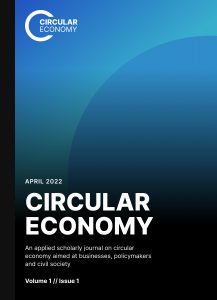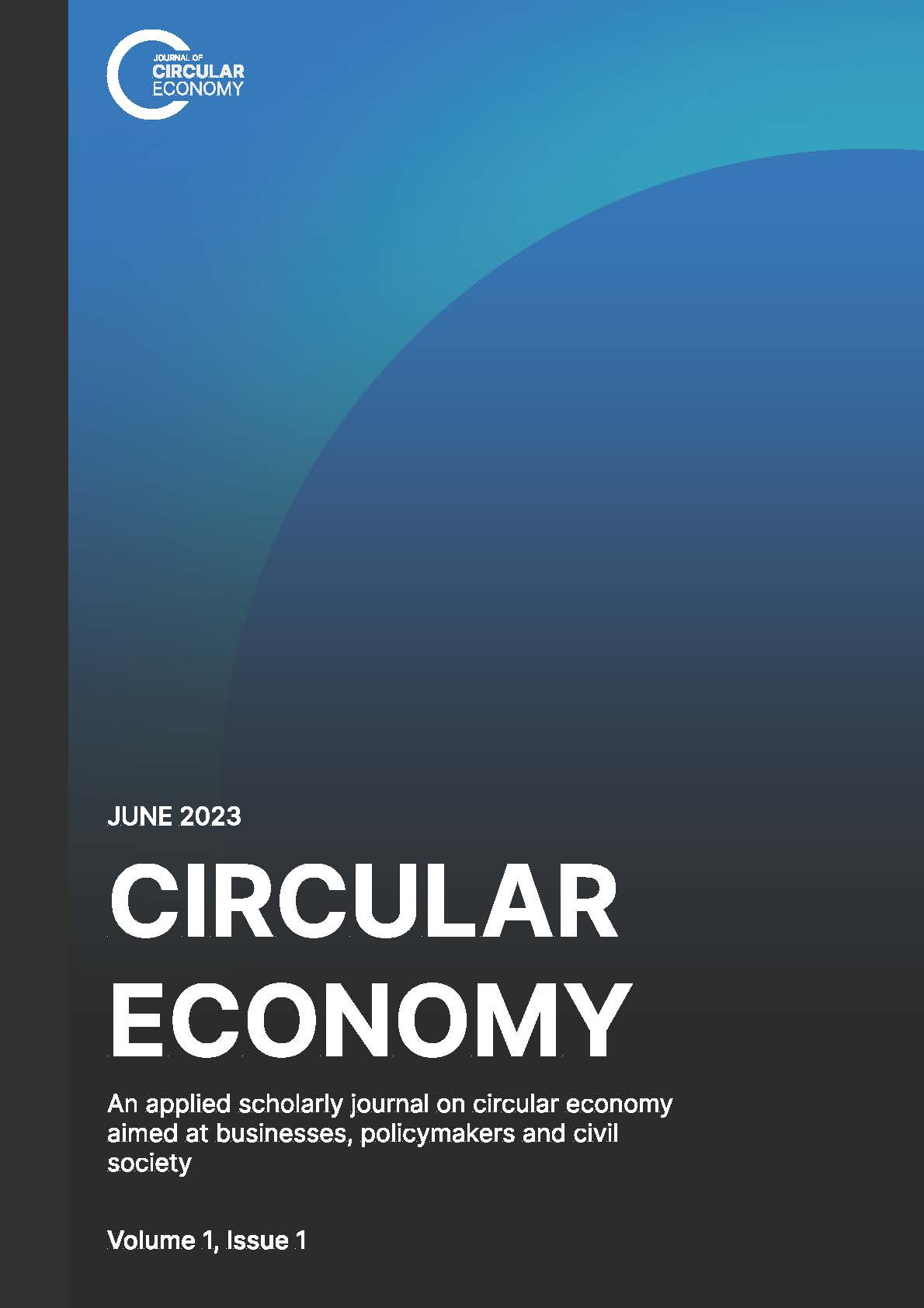Abstract
Keywords
References
ADEME, In Extenso Innovation Croissance, & Fraunhofer IZM, 2021. Preparatory study for the introduction of a durability index.
https://librairie.ademe.fr/dechets-economie-circulaire/4853-preparatory-study-for-the-introduction-of-a-durability-index.html (accessed 23 July 2022).
Akerlof, G.A., 1970. The market for “lemons”: Quality uncertainty and the market mechanism. The Quarterly Journal of Economics, 84(3), 488–500. https://doi.org/10.1016/B978-0-12-214850-7.50022-X
Arksey, H. & O’Malley, L., 2005. Scoping studies: towards a methodological framework. International Journal of Social Research Methodology, 8(1), pp.19–32. DOI: 10.1080/1364557032000119616
Artinger, S., Baltes, S., Jarchow, C., Petersen, M., & Schneider, A.M. (2018). Lifespan label for electrical products: Study on the effect of lifespan information for electrical products on the purchasing decision.
https://www.bundesregierung.de/resource/blob/1541604/323454/046091a8ccdc126cdfe3e827ed0c27c2/en-lebensdauer-downloadbericht-data.pdf?download=1 (accessed 17 July 2022).
Brocklehurst, F., Whittle, C., McAlister, C., & Whitmarsh, L., 2019. Can the provision of energy and resource efficiency information influence what consumers buy? A review of the evidence. In ECEEE 2019 Summer Study on Energy Efficiency: Is Efficient Sufficient? 1621–1630.
Böckin, D., Willskytt, S., André, H., Tillman, A.-M., & Ljunggren Söderman, M., 2020. How product characteristics can guide measures for resource efficiency – A synthesis of assessment studies. Resour. Conserv. Recy. 154, 104582. https://doi.org/10.1016/j.resconrec.2019.104582
Boyer, R.H.W., Hunka, A.D., Linder, M., Whalen, K.A., & Habibi, S., 2021. Product Labels for the Circular Economy: Are Customers Willing to Pay for Circular? Sustain. Prod. Consum. 27, 61–71.
https://doi.org/10.1016/j.spc.2020.10.010
Braithwate, N., Densley-Tingley, D., & Moreno, M., 2015. Should energy labels for washing machines be expanded to include a durability rating? PLATE 2015 Conference Proceedings.
http://irep.ntu.ac.uk/id/eprint/8546/1/220134_PubSub2377_Moreno.pdf
Burns, B., 2010. Re-evaluating obsolescence and planning for it. In T. Cooper (Ed.), Longer lasting products—Alternatives to the throwaway society, 39–60. Farnham, UK: Gower.
Cooper, R.D., & Gutowski, T.G. (2017). The environmental impacts of reuse: A review. Journal of Industrial Ecology, 21, 38–56. https://doi.org/10.1111/jiec.12388
Cooper, T., 2004. Inadequate life? Evidence of consumer attitudes to product obsolescence. J. Consum. Policy 27(4), 421–449. https://doi.org/10.1007/s10603-004-2284-6
Cooper, T., & Christer, K., 2010. Marketing durability, in: Cooper, T. (Ed.), Longer lasting products: alternatives to the throwaway society, 273–296. Farnham, UK: Gower.
Cox, J., Griffith, S., Giorgi, S., & King, G., 2013. Consumer understanding of product lifetimes. Resour. Conserv. Recy. 79, 21–29. https://doi.org/10.1016/j.resconrec.2013.05.003
Dalhammar, C., 2016. Industry attitudes towards ecodesign standards for improved resource efficiency. J. Clean. Prod. 123, 155–166. https://doi.org/10.1016/j.jclepro.2015.12.035
Dalhammar, C., Richter, J.L., & Machacek, E., 2018. Energy Efficiency Regulations, Market and Behavioural Failures and Standardization, in: Maitre-Ekern, E., Dalhammar, C., Bugge, H.C. (Eds.), Preventing Environmental Damage from Products – An Analysis of the Policy and Regulatory Framework in Europe, 176–228, Cambridge University Press, Cambridge.
Dünnhoff, E., & Palm, A., 2014. Comprehensibility of the EU Energy Label – Results of two focus groups and a representative consumer survey. Verbraucherzentrale Rheinland-Pfalz. https://www.verbraucherzentrale-rlp.de/sites/default/files/migration_files/media231718A.pdf (accessed 25 March 2022).
Echegaray, F., 2016. Consumers’ reactions to product obsolescence in emerging markets: The case of Brazil. J. Clean. Prod. 134, 191–203.
https://doi.org/10.1016/j.jclepro.2015.08.119
Ertz, M., François, J., & Durif, F., 2017. How consumers react to environmental information: An experimental study. J. Int. Consum. Mark. 29(3), 162–178.
https://doi.org/10.1080/08961530.2016.1273813
Fangeat, E., & Chauvin C., 2016. Allongement de la durée de vie des produits.
https://www.ademe.fr/sites/default/files/assets/documents/allongement_duree_vie_produits_201602_rapport.pdf (accessed 25 March 2022).
Gfk (2017). Consumer Market Study to support the Fitness Check of Consumer Rules. Publications Office of the European Union, Luxemburg.
http://ec.europa.eu/newsroom/just/item-detail.cfm?item_id=59332 (accessed 23 July 2022).
Gåvertsson, I., Milios, L., & Dalhammar, C., 2020. Quality Labelling for Re-used ICT Equipment to Support Consumer Choice in the Circular Economy. J. Consum. Policy 43, 353–377.
https://doi.org/10.1007/s10603-018-9397-9
Gnanapragasam, A., Cooper, T., Cole, C., & Oguchi, M., 2017. Consumer perspectives on product lifetimes: a national study of lifetime satisfaction and purchasing factors. In Product Lifetimes And The Environment 2017 Conference Proceedings, 144–148.
Guiltinan, J., 2009. Creative destruction and destructive creations: environmental ethics and planned obsolescence. J. Bus. Ethics, 89(1), 19–28. https://doi.org/10.1007/s10551-008-9907-9
Haberl, H., Wiedenhofer, D., Pauliuk, S., Krausmann, F., Müller, D.B., & Fischer-Kowalski, M., 2019. Contributions of sociometabolic research to sustainability science. Nat. Sustain. 2, 173–184. https://doi.org/10.1038/s41893-019-0225-2
Harms, R., & Linton, J.D., 2016. Willingness to Pay for Eco-Certified Refur- bished Products: The Effects of Environmental Attitudes and Knowledge: WTP for Eco-Certified Refurbished Products. J. Ind. Ecol. 20(4), 893–904. https://doi.org/10.1111/jiec.12301
Hennies, L., & Stamminger, R., 2016. An empirical survey on the obsolescence of appliances in German households. Resour. Conserv. Recy. 112, 73–82. https://doi.org/10.1016/j.resconrec.2016.04.013
Horne, R.E., 2009. Limits to labels: The role of eco-labels in the assessment of product sustainability and routes to sustainable consumption. Int. J. Consum. Stud. 33, 175–182. https://doi.org/10.1111/j.1470-6431.2009.00752.x
IRP, 2018. Re-defining value – The manufacturing revolution. In Remanufacturing, refurbishment, repair and direct reuse in the circular economy. Report of the International Resource Panel. United Nations Environment Programme, Nairobi, Kenya.
Jacobs, K., 2018. The Influence of Product Lifetime Labelling on Purchasing Electrical Appliances among German Consumers. Presented at the Ecodesign Conference: The ecodesign directive and the circular economy: How can we move forward? Brussels.
Jacobs, K., & Hörisch, J., 2022. The importance of product lifetime labelling for purchase decisions: Strategic implications for corporate sustainability based on a conjoint analysis in Germany. Bus. Strateg. Environ. 31(4), 1275–1291. https://doi.org/10.1002/bse.2954
Kahlin McVeigh, M., Dalhammar, C., & Richter, J.L., 2019. Planned obsolescence – Built not to last. https://liberalforum.eu/publication/planned-obsolescence-built-not-to-last/ (accessed 2 November 2022).
Khan, M.A., Mittal, S., West, S., & Wuest, T., 2018. Review on upgradability – A product lifetime extension strategy in the context of product service systems. J. Clean. Prod. 204, 1154–1168. https://doi.org/10.1016/j.jclepro.2018.08.329
Kirchherr, J., Reike, D., & Hekkert, M. (2017). Conceptualizing the circular economy: An analysis of 114 definitions. Resources, Conservation and Recycling, 127, 221–232. https://doi.org/10.1016/j.resconrec.2017.09.005
Knight, T., King, G., Herren, S., & Cox, J., 2013. Electrical and electronic product design: product lifetime. WRAP UK.
LE Europe, VVA Europe, Ipsos, ConPolicy, & Trinomics, 2018. Behavioural Study on Consumers’ Engagement in the Circular Economy. Brussels: European Commission. https://ec.europa.eu/info/sites/info/files/ec_circular_economy_final_report_0.pdf (accessed 8 July 2022).
Leenheer, J., Elsen, M., Mikola, N., van der Wagt, M., & Lloyd, L., 2014. Study on the effects on consumer behaviour of online sustainability information displays. Final Report prepared for the European Commission Executive Agency for Health and Consumers. https://op.europa.eu/en/publication-detail/-/publication/87c863a3-88af-4c8a-ab47-beab72de492e (accessed 8 July 2022).
Leire, C., & Thidell, Å., 2005. Product-related environmental information to guide consumer purchases – A review and analysis of research on perceptions, understanding and use among Nordic consumers. J. Clean. Prod. 13, 1061–1070. https://doi.org/10.1016/j.jclepro.2004.12.004
Levac, D., Colquhoun, H. & O’Brien, K.K., 2010. Scoping studies: advancing the methodology. Implementation Sci 5, 69. https://doi.org/10.1186/1748-5908-5-69
Longmuss, J., & Poppe, E., 2017. Planned obsolescence: who are those planners? PLATE 2017 conference proceedings. https://doi.org/10.3233/978-1-61499-820-4-217
Magnadóttir, B.G., Lien, T., Bergman, I.-M., Frenander, C., & Dreyer, R., 2017. Nordic Guidelines – Green Public Procurement: How to use environmental management systems and ecolabels in EU tenders. https://doi.org/10.6027/ANP2017-728
Marcus, J.S., Zachmann, G., Gardner, S., Tagliapietra, S., & Lykogianni, E., 2020. Promoting product longevity. Final Report for the European Parliament’s Committee on the Internal Market and Consumer Protection (IMCO). https://www.europarl.europa.eu/committees/en/study-promoting-product-longevity-/product-details/20200417CAN54506 (accessed 9 July 2022).
Maitre-Ekern, E., & Dalhammar, C., 2016. Regulating planned obsolescence: A review of legal approaches to increase product durability and reparability in Europe. Rev. Eur. Comp. Int. Environ. Law 25(3), 378–394. https://doi.org/10.1111/reel.12182
McKenzie-Mohr, D., & Smith, W., 1999. Fostering sustainable behaviour. An introduction to community based social marketing. Gabriola Island: New Society Publishers.
Milios, L., 2018. Advancing to a Circular Economy: three essential ingredients for a comprehensive policy mix. Sustain. Sci. 13(3), 861–878. https://doi.org/10.1007/s11625-017-0502-9
Milios, L., 2021. Overarching Policy Framework for Product Life Extension in a Circular Economy. Environ. Policy Gov. 31, 330–346. https://doi.org/10.1002/eet.1927
Milios, L., & Dalhammar, C., 2020. Ascending the Waste Hierarchy: Re-use potential in Swedish recycling centres. Detritus, 9, 27-37. https://doi.org/10.31025/2611-4135/2020.13912.
Mont, O., & Power, K., 2010. The role of formal and informal forces in shaping consumption and implications for sustainable society: Part I. Sustainability, 2(7), 2232–2252. https://doi.org/10.3390/su2072232
Mugge, R., Schoormans, J.P., & Schifferstein, H.N., 2005. Design strategies to postpone consumers’ product replacement: The value of a strong person-product relationship. Des. J. 8(2), 38–48. https://doi.org/10.2752/146069205789331637
Munn, Z., Peters, M.D.J., Stern, C., Tafunaru, C.,McArthur, A., & Aromataris, E., 2018. Systematic review or scoping review? Guidance for authors when choosing between a systematic or scoping review approach. BMC Med Res Method, 18, 143. https://doi.org/10.1186/s12874-018-0611-x
Pham, M.T., Rajić, A., Greig, J.D., Sargeant, J.M., Papadopoulos, A., McEwen, S.A., 2014. A scoping review of scoping reviews: advancing the approach and enhancing the consistency. Res Synth Methods 5(4):371–85. DOI: 10.1002/jrsm.1123
Prakash, S., Stamminger, R., Dehoust, G., Gsell, M., Schleicher, T., & Stamminger, R., 2016. Einfluss der Nutzungsdauer von Produkten auf ihre Umweltwirkung: Schaffung einer Informationsgrundlage und Entwicklung von Strategien gegen “Obsoleszenz”—On behalf of the Federal Ministry for Environment, Nature Conservation, Construction and Nuclear Safety .View PDF (accessed 13 July 2022).
Reike, D., Vermeulen, W. J. V., & Witjes, S., 2018. The circular economy: New or Refurbished as CE 3.0? Exploring Controversies in the Conceptualization of the Circular Economy through a Focus on History and Resource Value Retention Options. Resour. Conserv. Recy. 135, 246–264. https://doi.org/10.1016/j.resconrec.2017.08.027
Richter, J.L., Tähkämö, L., & Dalhammar, C., 2019. Trade-offs with longer lifetimes? The case of LED lamps considering product development and energy contexts. J. Clean. Prod. 226, 195–209. https://doi.org/10.1016/j.jclepro.2019.03.331
Sammer, K., & Wüstenhagen, R., 2006. The influence of eco-labelling on consumer behaviour—Results of a discrete choice analysis for washing machines. Bus. Strateg. Environ. 15(3), 185–199. https://doi.org/10.1002/bse.522
Sircome, University of South Brittany, & University of South Bohemia, 2016. ILLC study: The Influence of lifespan labelling on consumers—On behalf of the European Economic and Social Committee (CES/CSS/1/2015). https://www.eesc.europa.eu/sites/default/files/resources/docs/16_123_duree-dutilisation-des-produits_complet_en.pdf (accessed 23 July 2022).
Skylark, W.J., & Callan, M.J., 2021. Personal relative deprivation and pro-environmental intentions. PLoS ONE 16(11): e0259711. https://doi.org/10.1371/journal.pone.0259711
Sønderskov, K.M., & Daugbjerg, C., 2011. The State and Consumer Confidence in Eco-Labeling: Organic Labeling in Denmark, Sweden, The United Kingdom and The United States. Agric. Hum. Values 28(4), 507–517. https://doi.org/10.1007/s10460-010-9295-5
Swaen, V., Dupont, B., & Vanhamme, J., 2014. Labelling the durability of a product on its packaging: A pilot study. https://www.eesc.europa.eu/en/news-media/presentations/labelling-durability-product-its-packaging-pilot-study (accessed 7 March 2022).
Swaen, V., Munten, P., & Vanhamme, J., 2018. Labelling the durability – the reparability of a product. https://www.eesc.europa.eu/en/news-media/presentations/labelling-durability-reparability-product (accessed 8 March 2022).
Tang, E., Fryxell, G.E., & Chow, C.S.F., 2004. Visual and Verbal Communication in the Design of Eco-Label for Green Consumer Products. J. Int. Consum. Mark. 16(4), 85–105. https://doi.org/10.1300/J046v16n04_05
Teisl, M.F., Rubin, J., & Noblet, C.L., 2008. Non-Dirty Dancing? Inter-actions between Eco-Labels and Consumers. J. Econ. Psychol. 29(2), 140–159. https://doi.org/10.1016/j.joep.2007.04.002
Thøgersen, J., 2005. How may consumer policy empower consumers for sustainable lifestyles? J. Consum. Policy 28, 143–178. https://doi.org/10.1007/s10603-005-2982-8
Van Dam, Y.K., & Reuvekamp, M., 1995. Consumer knowledge and understanding of environmental seals in the Netherlands. In F. Hansen (Ed.), European advances in consumer research (Vol. 2, pp. 217–223). Provo: Association for Consumer Research.
van den Berge, R., & Thysen, T., 2020. State-of-the-art knowledge on user, market and legal issues related to premature obsolescence. Premature Obsolescence Multi-Stakeholder Product Testing Program (PROMT) – Deliverable 2.6. https://prompt-project.eu/wp-content/uploads/2020/07/PROMPT_20200430_State-of-the-art-overview-of-the-user-market-and-legal-aspects.pdf
van den Berge, R., Magnier, L., & Mugge, R., 2021a. A poorly educated guess: consumers’ lifetime estimations, attitudes towards repairability, and a product lifetime label. In Product Lifetimes And The Environment 2021 Conference Proceedings. http://hdl.handle.net/10344/10181
van den Berge, R., Magnier, L., & Mugge, R., 2021b. Too good to go? Consumers’ replacement behaviour and potential strategies for stimulating product retention. Curr. Opin. Psychol. 39, 66–71. https://doi.org/10.1016/j.copsyc.2020.07.014
van der Ven, H., 2019. Beyond Greenwash? Explaining Credibility in Transnational Eco-Labeling. Oxford University Press, UK: Oxford.
Van Nes, N., & Cramer, J., 2005. Influencing product lifetime through product design. Bus. Strateg. Environ. 14(5), 286–299. https://doi.org/10.1002/bse.491
VHK, 2016. Ecodesign impacts accounting – Annual Report 2016. https://ec.europa.eu/energy/sites/ener/files/documents/eia_ii_-_status_report_2016_rev20170314.pdf (accessed 25 July 2022).
Ward, D.O., Clark, C.D., Jensen, K.L., Yen, S.T., & Russell, C.S., 2011. Factors Influencing Willingness-to-Pay for the ENERGY STAR® Label. Energy Policy, 39(3), 1450–1458. https://doi.org/10.1016/j.enpol.2010.12.017
Wieser, H., & Tröger, N., 2018. Exploring the inner loops of the circular economy: Replacement, repair, and reuse of mobile phones in Austria. J. Clean. Prod. 172, 3042–3055. https://doi.org/10.1016/j.jclepro.2017.11.106
Wilson, G.T., Smalley, G., Suckling, J.R., Lilley, D., Lee, J., & Mawle, R., 2017. The hibernating mobile phone: Dead storage as a barrier to efficient electronic waste recovery. Waste Manag. 60, 521-533. https://doi.org/10.1016/j.wasman.2016.12.023


